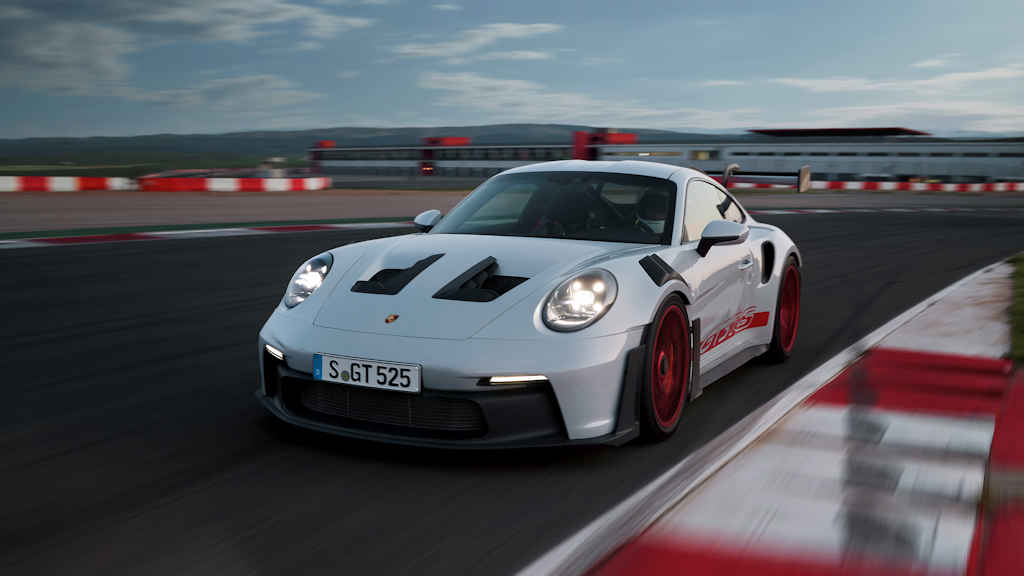Porsche’s road-legal high-performance sportscar, the 911 GT3 RS gets an upgrade that brings even more motorsports technologies and know-how to the road.
Inspired by the Porsche 911 RSR and the 911 GT3 R, the 911 GT3 RS gets a central radiator. Instead of the three-radiator layout seen in previous cars, the new 911 GT3 RS relies on a large, angled center radiator in the car’s nose, positioned where the luggage compartment is located on other 911 models. This has made it possible to use the space freed up on the sides to integrate active aerodynamic elements. Continuously adjustable wing elements in the front and on the two-part rear wing, in combination with a number of other aerodynamic measures, provide more than 400 kilograms of downforce at 200 km/h—three times as much as the current 911 GT3. At 285 km/h, the total downforce is around 859 kilograms, or equivalent to a Porsche 356 A.
A drag reduction system (DRS) is fitted in a production Porsche for the first time. To achieve low drag and higher speeds on straight sections of the track, the DRS allows the wings to be flattened out at the push of a button, within a specific operating range. During hard braking at high speeds, the airbrake function positions the wing elements at the front and rear to support deceleration by maximize aerodynamic drag.
The new 911 GT3 RS also features a number of functional aero elements. The most prominent feature of the GT sports car is the swan-neck-supported rear wing, which is significantly larger in all dimensions than the wing of its predecessor. The rear wing consists of a fixed main wing and a hydraulically adjustable upper blade. For the first time on a Porsche production vehicle, the upper edge of the rear wing is higher than the roof.
Underneath, the GT3 RS’s suspension has been modified for improved aerodynamics as well. Because the wheel arches of the new 911 GT3 RS are subject to powerful airflows, the components of the double-wishbone front axle are designed with teardrop-shaped profiles. These aerodynamically efficient links increase downforce on the front axle by around 40 kilograms at top track speed and are otherwise only used in high-end motorsport applications. Front track width increases by 29 millimeters, necessitating longer double-wishbone front axle links.
The 911 GT3 RS offers three driving modes: Normal, Sport and Track. In Track mode, the basic settings can be individually adjusted. Among other settings, the rebound and compression damping of the front and rear axles can be adjusted separately and in several stages. The rear differential can also be adjusted via rotary controls on the steering wheel. At the touch of a button, the driver can reduce the two seven-inch side displays to essential information only. The gearshift indicator lights to the left and right of the analog tachometer have also been taken from the 911 GT3.
At the heart of the 911 GT3 RS is a high-revving 4.0-liter flat-6 producing 518 horsepower—16 more than the GT3. The bump in output was achieved via new camshafts with modified cam profiles. The single-throttle intake system and the rigid valvetrain are derived from motorsport. Like the 911 GT3, this engine also has six individual throttle bodies; one per cylinder. The seven-speed dual-clutch also has a shorter overall gear ratio than the 911 GT3 and is aided by air intakes on the underbody to ensure that the transmission can withstand even extreme loads during frequent use on track.
Six-piston aluminum monobloc fixed-caliper brakes and brake discs with a diameter of 408 mm are used on the front axle. Compared with the 911 GT3, the piston diameters have been increased from 30 to 32 mm. In addition, the thickness of the discs has been increased from 34 to 36 mm. The rear axle continues to be fitted with 380-mm brake discs and four-piston fixed-caliper brakes. Ceramic composite brakes are an available option. It also comes standard with forged light-alloy center-locking wheels. Street-legal Ultra High-Performance tires measuring 275/35R20 at the front and 335/30 R21 at the rear provide a high level of mechanical grip.
Thanks to an array of lightweight construction measures such as the extensive use of carbon fiber reinforced plastic (CFRP), the 911 GT3 RS weighs in at only 1,482 kilograms. The doors, front quarter panels, roof and hood, for example, are made from CFRP. Lightweight CFRP is also used in the interior, including the standard full bucket seats, trimmed in black leather and Race-Tex joining carbon fiber trim throughout the interior to characterize the pure, sporty ambience.
For those who want something a bit more, the 911 GT3 RS can be ordered with the optional Weissach package. This includes a considerable number of changes to the standard vehicle. The hood, roof, parts of the rear wing and the upper portion of the side mirrors housing feature visible carbon fiber. The front and rear anti-roll bars, the rear coupling rods and the shear panel on the rear axle are made of CFRP and contribute to a further enhancement of the driving dynamics. Another highlight of the Weissach package is the PDK shift paddles with motorsport-derived magnet technology. This makes gear changes feel especially precise thanks to a pressure point and a clearly perceptible click. Forged magnesium wheels are included in the Weissach package and save a further 8 kilograms of weight compared to the standard wheels.
Porsche is already taking orders for the new 911 GT3 RS, with customer deliveries to start by March of 2023.













No comments:
Post a Comment
Feel free to comment or share your views. Comments that are derogatory and/or spam will not be tolerated. We reserve the right to moderate and/or remove comments.